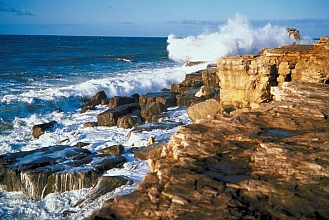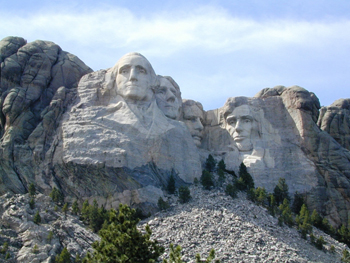The granite rocks that make up Mt. Rushmore crystallized from magma that formed 1.7 billion years ago.
Click on image for full size
Courtesy of Peter Nabelek, University of Missouri
Earth's Crust Melts Easier Than Thought
News story originally written on March 18, 2009
In places where continents are slowly smashing into each other and mountains are growing, could it get hot enough in the Earth’s crust for rocks to melt?
A team of scientists looked at this question. They discovered that the rocks of the Earth's crust melt more easily than they thought. They found that as rocks get hotter, they hold onto heat and don’t easily let it go.
We know that rocks melt when continents collide and mountains are built, because there is evidence preserved in the rocks. But scientists wanted to know how this worked. They heated rocks with lasers and measured how long it took heat to conduct through different types of rock. The scientists noticed that as the heat was increased, the rocks lost some of their ability to conduct. The rocks held onto the heat.
In places where continents are colliding and mountains are forming, the strain of all that moving rock makes heat. This experiment suggests that once the rocks are heated, they stay hot for much longer.
The scientists put their findings into computer models that predict what happens to rocks when they get buried and heat up as mountains form. Hopefully this research will help make the models more accurate.
Last modified April 24, 2009 by Lisa Gardiner.
You might also be interested in:

Scientists have learned that Mount Hood, Oregon's tallest mountain, has erupted in the past due to the mixing of two different types of magma. Adam Kent, a geologist at Oregon State University, says this
...more
The Earth's mantle is a rocky, solid shell that is between the Earth's crust and the outer core. The mantle is made up of many different reservoirs that have different chemical compositions. Scientists
...more
Some faults look strong and like they wouldn’t cause an earthquake. But it turns out that they can slip and slide like weak faults causing earthquakes. Scientists have been looking at one of these faults
...more
The sun goes through cycles that last approximately 11 years. These solar cycle include phases with more magnetic activity, sunspots, and solar flares. They also include phases with less activity. The
...more
Studying tree rings doesn't only tell us the age of that tree. Tree rings also show what climate was like while the tree was alive. This means that tree rings can tell us about climates of the past. Two
...more
Earth's first life form may have developed between the layers of a chunk of mica sitting like a multilayered sandwich in primordial waters, according to a new hypothesis. The mica hypothesis, which was
...more
Acid rain is what happens when some types of air pollution is washed out of the sky by rain. Power plants, factories, farms, houses, and cars all put pollution into the atmosphere. Sometimes, this pollution
...more















